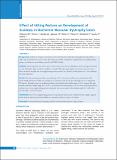Please use this identifier to cite or link to this item:
https://hdl.handle.net/20.500.14356/1804Full metadata record
| DC Field | Value | Language |
|---|---|---|
| dc.contributor.author | Pokharel, R K | - |
| dc.contributor.author | Brisco, L | - |
| dc.contributor.author | Mandal, M | - |
| dc.contributor.author | Agrawal, J P | - |
| dc.contributor.author | Dillon, D | - |
| dc.contributor.author | Vitale, M | - |
| dc.contributor.author | Woodland, P | - |
| dc.contributor.author | Jacoby, P | - |
| dc.contributor.author | Downs, J | - |
| dc.date.accessioned | 2023-05-23T07:10:39Z | - |
| dc.date.available | 2023-05-23T07:10:39Z | - |
| dc.date.issued | 2014 | - |
| dc.identifier.citation | PokharelR. K., BriscoL., MandalM., AgrawalJ. P., DillonD., VitaleM., WoodlandP., JacobyP., & DownsJ. (2014). Effect of Sitting Posture on Development of Scoliosis in Duchenne Muscular Dystrophy Cases. Journal of Nepal Health Research Council. https://doi.org/10.33314/jnhrc.v0i0.496 | en_US |
| dc.identifier.issn | Print ISSN: 1727-5482; Online ISSN: 1999-6217 | - |
| dc.identifier.uri | http://103.69.126.140:8080/handle/20.500.14356/1804 | - |
| dc.description | Original Article | en_US |
| dc.description.abstract | Abstract Background: Scoliosis is a frequent association in boys with Duchenne Muscular Dystrophy when the ability to walk is lost around nine to 12 years of age. This study assessed the contribution of physical factors including lumbar posture to scoliosis in non-ambulatory youth with DMD in Nepal.  Methods: Linear regression was used to assess effects of time since loss of ambulation, muscle strength, functional severity and lumbar angle as a binary variable on coronal Cobb angle; again logistic regression was used to assess effects of muscle strength and cross-legged sitting on the presence of a lordotic lumbar posture in 22 non-ambulant boys and young men.  Results: The boys and young men had a mean (SD) age of 15.1 (4.0) years, had been non-ambulant for 48.6 (33.8) months and used a median of 3.5 (range 2 to 7) postures a day. The mean Cobb angle was 15.1 (range 0 to 70) degrees. Optimal accuracy in predicting scoliosis was obtained with a lumbar angle of -6° as measured by skin markers, and both a lumbar angle =-6° (P=0.112) and better functional ability (P=0.102) were associated with less scoliosis. Use of cross-legged sitting postures during the day was associated with a lumbar angle =-6° (OR 0.061; 95% CI 0.005 – 0.672; P=0.022).  Conclusions: Use of cross-legged sitting posture was associated with increase in lumbar lordosis. Higher angle of lumbar lordosis and better functional ability are associated with lesser degree of scoliosis.  Keywords: Duchenne Muscular Dystrophy; lumbar lordosis; lumbar posture; Nepal; scoliosis. | en_US |
| dc.language.iso | en | en_US |
| dc.publisher | Nepal Health Research Council | en_US |
| dc.relation.ispartofseries | May-Aug, 2014;496 | - |
| dc.subject | Duchenne Muscular Dystrophy | en_US |
| dc.subject | Lumbar lordosis | en_US |
| dc.subject | Lumbar posture | en_US |
| dc.subject | Nepal | en_US |
| dc.subject | Scoliosis | en_US |
| dc.title | Effect of Sitting Posture on Development of Scoliosis in Duchenne Muscular Dystrophy Cases | en_US |
| dc.type | Journal Article | en_US |
| local.journal.category | Original Article | - |
| Appears in Collections: | Vol. 12 No. 2 Issue 27, May - Aug 2014 | |
Files in This Item:
| File | Description | Size | Format | |
|---|---|---|---|---|
| 496-Article Text-753-1-10-20141121.pdf | Fulltext Download | 143.4 kB | Adobe PDF |  View/Open |
Items in DSpace are protected by copyright, with all rights reserved, unless otherwise indicated.
